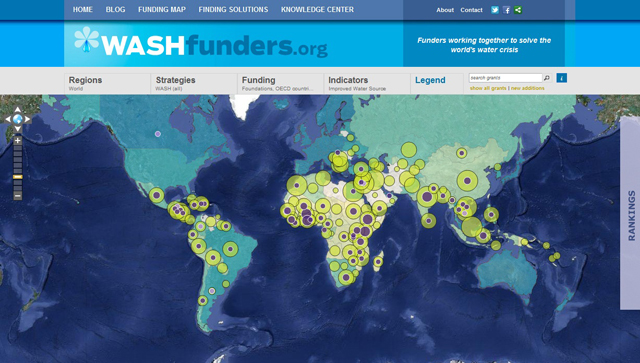How has environmental philanthropy changed since the 2008 financial crisis? What environmental priorities are still receiving funding and which are struggling? How can foundation staff across the field connect efficiently to collaborate?
The Environmental Grantmakers Association and the Foundation Center addressed these questions and others in Tracking the Field Volume 3: Exploring Environmental Grantmaking, a report released this week that includes a new interactive searchable environmental grants database.
By partnering with the Foundation Center, EGA has been able to analyze data collected from both EGA members and nonmembers, making it possible to examine the broader field of environmental philanthropy. This evolving partnership offers promise of real-time updates and portals like Washfunders.org (more below) that the Foundation Center is creating for other sectors. Here are some highlights of the report and some new tools for using the knowledge.
The great recession and environmental philanthropy
While 2009 was a financially difficult year for philanthropy and society generally, environmental philanthropy was impacted less than other issue areas were. The more than 76,000 foundations based in the US collectively gave 42.8 billion in grants across all philanthropic issues. This marked a 2.1 percent decrease in giving from 2008. US environmental grantmaking, however, remained consistent at $2.7 billion. This shows a significant prioritization of environmental issues (although they are still a relatively small piece of the pie) despite a 17.2 percent overall loss in foundation assets in 2008.
Shifts in environmental funding priorities
Are you enjoying this article? Read more like this, plus SSIR's full archive of content, when you subscribe.
The distribution of environmental grant dollars changed in 2009. For example, reductions in giving by EGA member foundations had a larger impact on traditional ecosystems nonprofits, which focus on land, water, and species preservation. These organizations were impacted by both the decrease in EGA member funding and a shift in focus by environmental foundations generally. Funding for traditional ecosystems issues by EGA members decreased by 37 percent between 2007 and 2009 while funding for organizations and programs addressing climate issues increased by 92 percent.
Climate-focused nonprofits continued to see growth in funding despite foundations’ shrinking endowments. The share of funding for “Climate & Atmosphere” and “Energy” (EGA’s descriptions of these categories can be seen here) by EGA members leaped from 13.7 percent in 2007 to 31.9 percent in 2009, reflecting a huge investment in climate legislation domestically and in treaties at the global level.
Where is the funding not going?
The issue areas of “Population” (with only 0.1 percent of funding) and “Material Consumption & Waste Management” (1 percent) remained—as in 2007—the least funded. “Environmental Health,” “Environmental Justice,” and “Toxics” received more than $36 million from EGA members (4 percent) while receiving only 1 percent of total environmental grant dollars. This represents a 53 percent decrease in funding by EGA members between 2007 and 2009, and a 23 percent decrease overall.
Environmental funding strategies
Tracking the Field Volume 3 is the first report to track environmental grantmaking strategies. EGA members’ top strategies in 2009 focused on “Advocacy/Organizing/Movement Building,” followed by “Capacity Building/General Support.” A number of funders reported that the recession influenced them to increase their general support grantmaking (versus funding specific programs or projects) so as to provide nonprofits with more flexibility.
 This data is important because it allows the field to understand its history and to speculate on future trends. Will climate continue to grow or will a new issue area begin to dominate in the next few years? What impact will the changing priorities of grantmakers have on issues that require long-term commitment? And how can environmental funders and other sectors of philanthropy work together to ensure better communication and collaboration?
This data is important because it allows the field to understand its history and to speculate on future trends. Will climate continue to grow or will a new issue area begin to dominate in the next few years? What impact will the changing priorities of grantmakers have on issues that require long-term commitment? And how can environmental funders and other sectors of philanthropy work together to ensure better communication and collaboration?
A new resource
The newly released Tracking the Field database allows EGA members (it is member-only, since the need for trust in providing data by foundations is crucial for real-time information sharing) to search more than 8,000 coded grants by issue, geography, strategy, and grantor and/or grantee. It also contains information on all grants made by a member, members’ contact information, and all grants received by a grantee.
The Foundation Center also recently launched a portal called Washfunders.org, with tools tailored specifically to water access, sanitation, and hygiene (WASH) issues. At its core is a robust GIS-mapping tool that shows the global reach of WASH funders and how their investments compare to those of government development assistance agencies around the world.
Technology and social media have dramatically changed all aspects of our lives and philanthropy should evolve as well. But data-driven resources require an ever-growing degree of transparency—something there is little consensus about in philanthropy. While some foundations have searchable databases on their websites, 1/3 of foundations with assets over $100 million still do not even have websites. And while some 700 foundations now report current-year grant data to the Foundation Center digitally, our reliance on IRS 990PF data delays analysis and updates to our databases.
But it’s only the beginning. Philanthropy—environmental and otherwise—needs to continue to explore the transformative potential of data, technology, and social networking in helping grantmakers work more effectively.
Support SSIR’s coverage of cross-sector solutions to global challenges.
Help us further the reach of innovative ideas. Donate today.
Read more stories by Rachel Leon & Bradford K. Smith.


